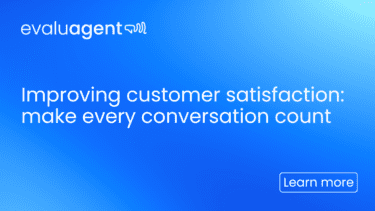Improving Customer Satisfaction: Make Every Conversation Count


Contact centres have always been a key touchstone for customer satisfaction, customer experience, and customer resolution – the difference now is the power that a single conversation can have.
In today’s climate, our customers are empowered by:
All this means it’s easier than ever for customers to go elsewhere. According to PwC, 1 in 3 customers would leave a brand they love after just one bad experience.
The flip side is that every conversation offers the opportunity to investigate problems and identify solutions, both during the interaction and reflecting back.
This is what optimised, efficient QA looks like. But before you can begin oiling the mechanism of conversations to improve customer satisfaction, you need to harvest your baseline insights.
When it comes to improving customer satisfaction, there are two parts of the equation.
First, you have to monitor how happy your customers are with your service by gathering customer feedback and trends in customer data. This is a direct measure of your customers’ satisfaction and is something your contact centre is likely already doing.
The second half of the equation is quality assurance, which is the internal assessment of the service your agents provide. Because, to begin positively impacting customer satisfaction, you can’t just look at stand-alone data like CSAT scores.
Without context, there is no clear action point, and feedback quickly becomes a source of de-motivation for agents. That’s why your customer satisfaction monitoring needs to go hand-in-hand with agent performance monitoring and training.
Let’s get familiar with common customer satisfaction metrics, then take a closer look at how they fit together with quality assurance.
Customer Satisfaction or CSAT measures how satisfied your customers are with the service provided by your contact or call centre, and it can apply to any part of the customer journey. It is usually measured by a question such as ‘On a scale of 1-10, how satisfied are you with the service you’ve received today?’
The data is collected after specific interactions, such as purchasing a product or contacting the complaints department. As such, it’s a temperature test that tells you how well a particular interaction went.
You might be familiar with NPS; a metric that shows how likely your current customers are to refer your business to friends.
Net Promoter Score, also known as NPS, measures how loyal customers are to your brand and is a key outcome in customer experience. It is different from the ‘snapshot’ insight of CSAT scores because it captures the customer’s long-term feelings and intentions. It is typically formulated as a single question: “How likely are you to recommend [company] to friends/family/colleagues?”
Quality Assurance (QA) is a way to observe contact centre interactions and measure the standard of service that agents deliver. When done right, it’s a springboard that turns every conversation into an opportunity for agent development. It creates better insights and better training that allows agents to engage with higher-level performance.
Because it’s not just the agent-customer conversations that matter, it’s about internal conversations (feedback, coaching, and more formal one-to-ones) that motivate, inspire and develop your front-line teams. They’re the key to closing the loop in QA and empowering agents to have better conversations with customers.
Research shows the quality of feedback received is a top driver of employee engagement. And in turn, happy employees mean happy customers.
QA measures set criteria defined by you. It’s typically geared to monitor agent performance and may include criteria such as:
What you measure (and why) will be determined by the unique challenges your call centre faces. But when it comes to using QA to improve customer satisfaction, the defining principle is how you do it.
With thousands of daily interactions, growing teams, and remote workforces, one of the greatest challenges contact centres face is understanding where conversations go right and where they go wrong, even when QA is in place.
That’s no surprise, given traditional QA actively monitors less than 3% of conversations. What’s more, it’s often inefficient. QA becomes an admin sinkhole, eating up time in exchange for out-of-date reports.
Before you know it, what began as an attempt to improve your KPIs can instead damage them. But it doesn’t have to be this way.
Smart Quality is a brand new approach that supercharges QA to increase coverage, gain actionable insight and engage performance management to close the loop with agents.
Here are just five ways this approach stands out from traditional QA to improve customer satisfaction.
In the hustle and bustle of contact centre QA, it’s easy to focus on the outputs of great conversations, i.e., your KPIs. But, before you can start influencing these metrics, you have to start with the foundations of a great conversation. That means measuring what matters and ensuring you have the right balance of customer needs, business expectations and compliance with regulatory requirements.
The essentials above can come down to an agent’s personality and training, but they can also be helped or hindered by technology. 60% of contact centre agents say their company doesn’t give them the right tech to address CX challenges. Effective QA should remove barriers to great conversations both in training and technology.
Companies underestimate the importance of understanding how customers feel. Rather than relying solely on CSAT or quality scores, your QA needs to recognise that every nuance counts. You can do this by transcribing every call, auto-scoring for sentiment, friendliness, and then combining with KPIs like CSAT and NPS. Then you can take a deep dive into insights that actually mean something.
Companies tend to focus too much on the onboarding process and less on customer retention. A better approach is to mine transcribed calls for specific keywords and begin evaluating the success of conversations at all stages of your customer journey. To do this, you need a centralised and fully integrated system for your QA.
Insight without action becomes a meaningless tick box exercise. Evaluation needs full integration with engagement; feedback, one-to-ones, coaching, and eLearning, as well as the ability to track improvements over time. With rich, customer-focused, AI-based tools integrated into your QA system, this type of strategy is available and accessible even for smaller contact centres.

